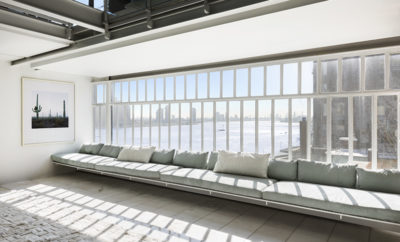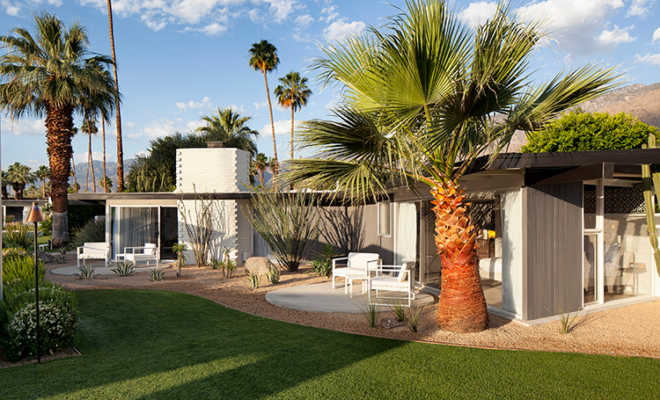 A view of the exterior of L’Horizon Resort and Spa, designed in 1952 by architect William F. Cody. COURTESY OF L’HORIZON RESORT AND SPA.
A view of the exterior of L’Horizon Resort and Spa, designed in 1952 by architect William F. Cody. COURTESY OF L’HORIZON RESORT AND SPA.
Design Destination
Palm Springs: Design Heats Up
IN HIS 1906 BOOK, The Wonders of the Colorado Desert, George Wharton James described Palm Springs as “most beautiful, interesting, and delightful. . . . A natural oasis improved by man.” Most visitors who find themselves in the warm, sun-kissed desert town—situated on the western edge of the Coachella Valley and at the foot of the San Jacinto Mountains—would likely agree with James. Since the 1920s and ’30s, Palm Springs has been a retreat for Hollywood stars, including the likes of Frank Sinatra (who has a thoroughfare named after him there), Zsa Zsa Gabor, and, more recently, Leonardo DiCaprio. But it is equally recognized for its concentration of noteworthy mid-century architecture. The leading talents of the day—such as John Lautner, A. Quincy Jones, and Richard Neutra—were drawn to the area’s palm tree–lined roads, craggy burnt-orange mountains, and imposing sky. This enclave of Southern California architects integrated Europe’s Bauhaus aesthetic and the International Style into their own design vernacular, playing off the landscape—and ushering in what is known today as desert modernism. With a wealth of design, and near perfect weather, Palm Springs is on the ascent and proving to be more than just a seasonal resort town.
SIGHTSEEING
ART & ARCHITECTURE
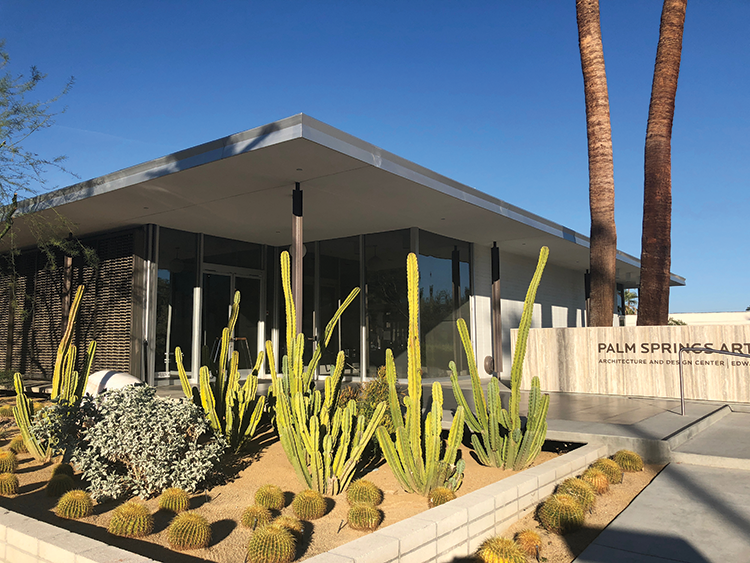
The Palm Springs Art Museum’s Architecture and Design Center, designed in 1961 by E. Stewart Williams. Nicole Anderson photo.
PALM SPRINGS ABOUNDS WITH MODERNIST architecture, much in plain sight, and others relatively hidden from view, often discreetly sheltered behind hedges of leafy palms. The best way to maximize your design sleuthing is to reserve a spot on Michael Stern’s “The Modern Tour,” a highly curated two-and-a-half-hour sightseeing exploration around the city, with visits to private residences, such as the Dr. Franz Alexander House by Walter White and William F. Cody’s Glass House. As the co-author of Julius Schulman: Palm Springs and the new Hollywood Modern: Houses of the Stars, Stern offers in-depth knowledge of the city’s architecture—from interesting historical tidbits on zoning and the local flora and fauna to fun celebrity stories—managing to be at once entertaining and edifying. Often included on Stern’s tour is the iconic Albert Frey House II, the personal residence designed by Swiss-born architect Albert Frey, who lived there for more than thirty years, and which is now under the stewardship of the Palm Springs Art Museum (Stern is the only private operator with exclusive access to show Frey House II). Well worth a visit, the Frey House II is nestled into the hillside and has sweeping views of the valley and mountains. The home was, as the museum’s brochure explains, “designed as compactly as a ship,” with built-in seating and cabinets. Constructed with durable materials—steel, glass, and corrugated aluminum—it embraces its natural surroundings, integrating a massive boulder right into the interior.
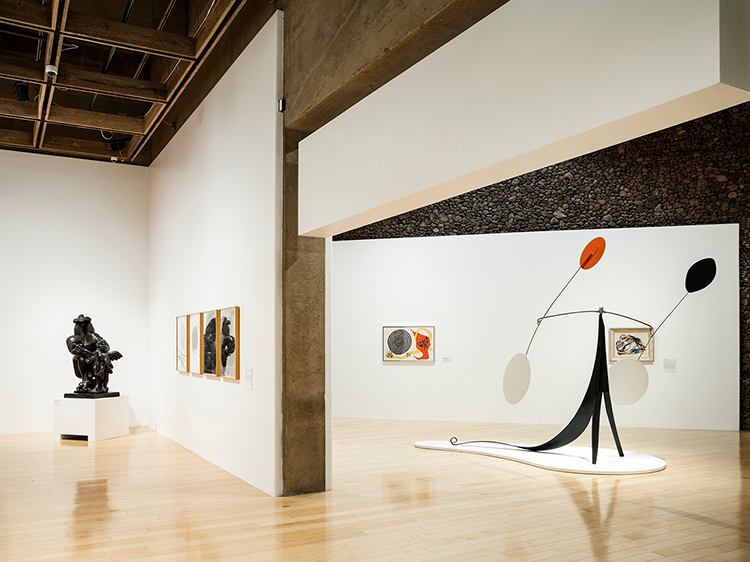
An interior view of the Palm Springs Art Museum. Lance Gerber photo, courtesy of the Palm Springs Art Museum.
Just down the hill stands the brutal-esque Palm Springs Art Museum, designed by E. Stewart Williams. The spacious eighty-year-old institution has ample room to show its impressive permanent collection—including works by Louise Bourgeois and Alexander Calder—as well as to stage large-scale exhibitions. Across the street from the museum, a replica of Paul Rudolph’s 1952 Walker Guest House is taking up temporary residence, right beside giant eight-foot-tall sculptures of crawling Babies by Czech Republic artist David Černý. Don’t miss PSAM’s Architecture and Design Center, the Edwards Harris Pavilion, which is only a short walk, located in down-town Palm Springs. Housed in the former Santa Fe Federal Savings and Loan building, also designed by E. Stewart Williams, the A+D Center is under the leadership of Brooke Hodge, the museum’s first director of architecture and design, who is introducing compelling programming, such as a forthcoming exhibition highlighting the pioneering work of local, not yet widely known architect Hugh Kaptur.
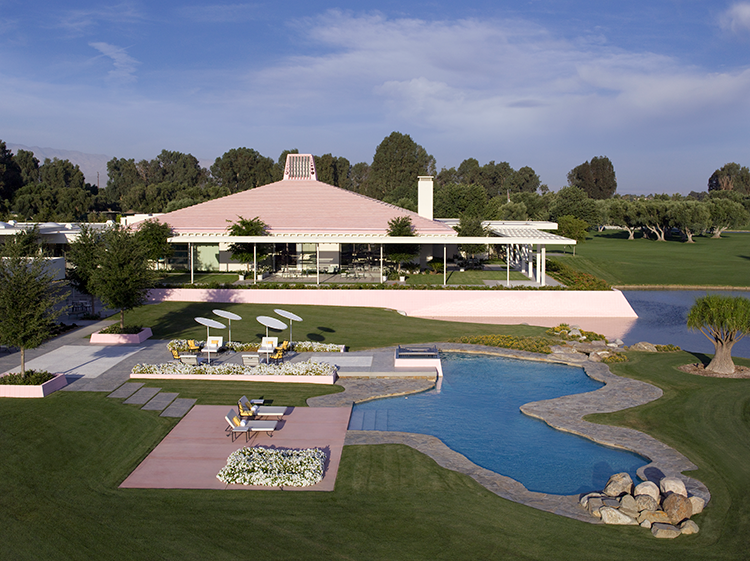
An exterior rear view of the historic Sunnylands estate, built by A. Quincy Jones, 1966. Courtesy Modernism Week
While there is much to see in Palm Springs, a drive to the sprawling Sunnylands Center & Gardens in Rancho Mirage is a must. The two-hundred-acre estate of media magnate and philanthropist Walter Annenberg and his wife, Leonore (who served as Ronald Reagan’s chief of protocol), opened to the public in 2012 and offers tours, exhibitions, and other programming, while carrying on its legacy as a retreat for political summits with world leaders. The 25,000-square-foot home conceived by A. Quincy Jones in 1966 is a wild mash-up of modernism and Hollywood regency, with interiors and furnishings designed by William Haines and Ted Graber. Visitors can glimpse the vast landscaped grounds, containing a golf course, ponds, and outdoor sculptures.
FESTIVALS & HAPPENINGS
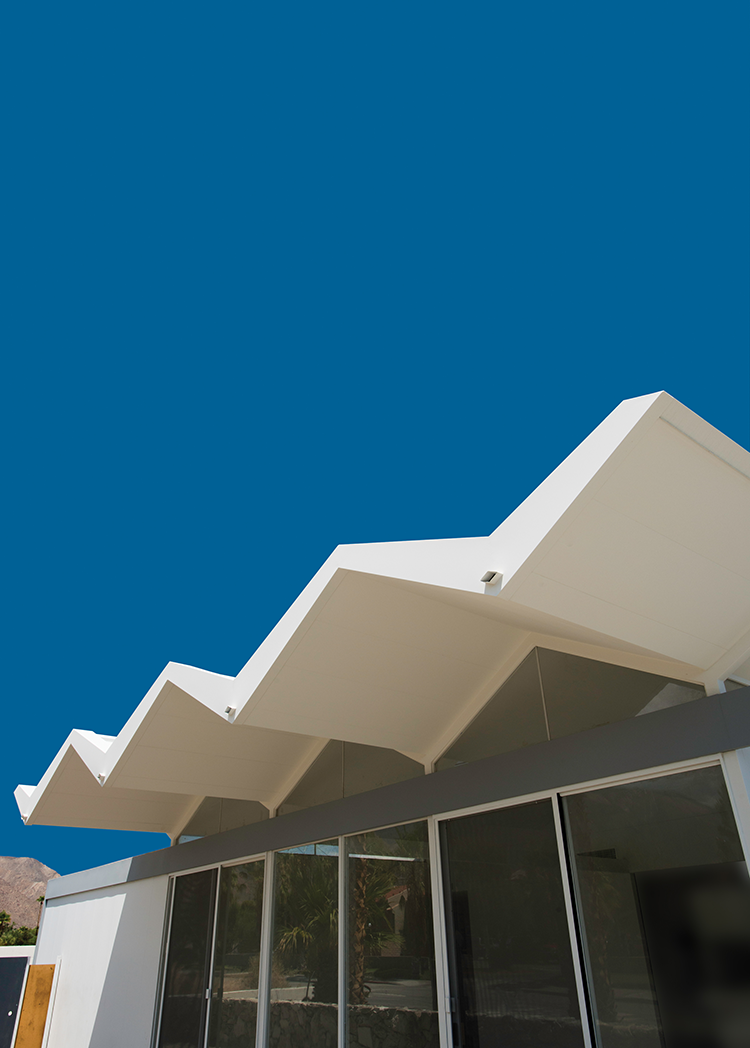
One of Donald Wexler’s prefabricated Steel Houses in Palm Springs, which he began in 1961 and were rediscovered in the early 1990s. Most of the buildings have been restored. Jim Riche photo.
THERE IS NO BETTER WAY TO CELEBRATE THE tradition and ongoing influence of modernism than at Modernism Week, the fourteenth edition of which the city will host from February 14 to 24, 2019. On the docket is a full schedule of talks, parties, architectural biking and bus tours, film screenings, events like the Palm Springs Modernism Show & Sale, and more (tickets sell out quickly for many of these events). The festivities will kick off with cocktails and dancing at the opening night party, Modern Love, held at the 1962 Wexler and Harrison–designed Indian Canyons Golf Resort Clubhouse.
Highlights of the festival include exclusive tours of four homes, including Green Gables, a residence designed by Palmer & Krisel around 1957 and undergoing a renovation by design consulting firm H3K. The Christopher Kennedy Compound presents a show house in an immaculately restored mid-century home in Indian Canyons, featuring the work of a dozen interior designers. For Frey fans, the Cree House, an architectural gem that has never before been seen by the public, will open its doors to visitors. In addition to house tours, there will be plenty of nostalgia-leaning entertainment, from the Nod to Mod dinner to performances by the Aqualillies, a group of synchronized swimmers.
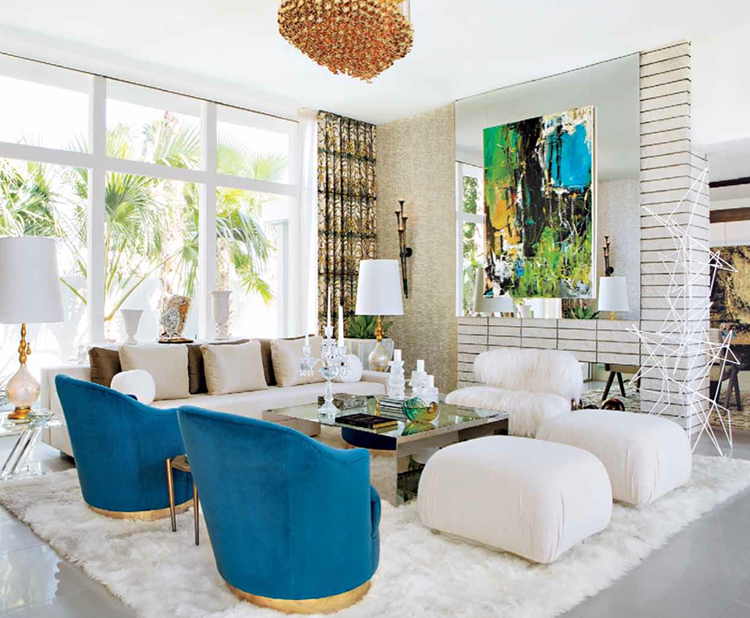
Woodson and Rummerfield’s designed the living room in the Christopher Kennedy Compound show house for Modernism Week in 2014. Ken Hayden photo, © The Annenberg Foundation Trust at Sunnylands.
Coinciding with Modernism Week is Desert X, a site-specific biennial exhibition, returning for the second time to the Coachella Valley, from February 9 to April 21, 2019. A roster of international artists will create large-scale works inspired by the desert environment, and placed in different locations. A favorite from 2017 was Doug Aitken’s Mirage, a mirrored house that reflected the rugged landscape and changing light.
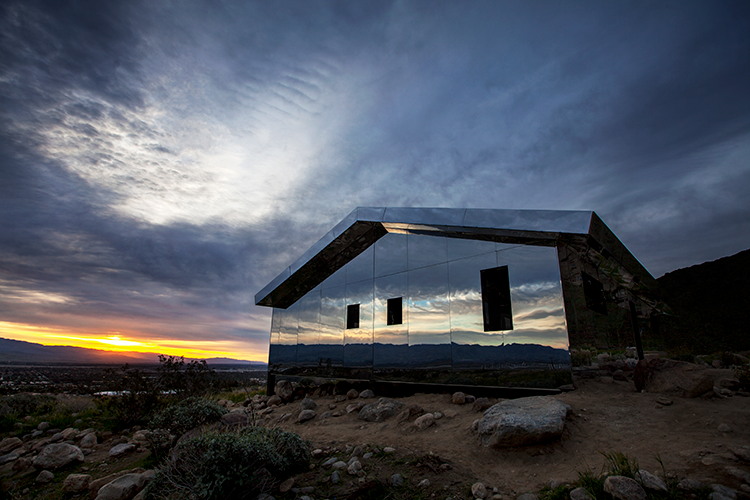
Installation view of Mirage by Doug Aitken, 2017, part of Desert X, a site-specific contemporary art exhibition. Doug Aitken Workshop photo, courtesy of the artist and Desert X.
SHOPPING
THE REVITALIZATION OF THE UPTOWN DESIGN District in the last decade has transformed the once deserted strip of North Palm Canyon Drive into a popular hub for design and vintage shopping. Start out at the Palm Canyon Galleria with its arcade of shops offering an eclectic swath of twentieth-century art and design. Farther up the street, Bon Vivant, located in the historic Kocher-Samson Building (the first project designed by Albert Frey in Palm Springs) tenders an exceptional array of objects, including Blenko glass and Italian pottery. Take a moment to glimpse the International Style building’s elegant spiral staircase. Just next door is the exquisitely curated Flow Modern, owned by husband-and-wife design duo Andre Boughtwood and Brigitte Lehnert. The gallery exhibits a mix of art, design, and jewelry, representing California artists as well as displaying midcentury furniture by noteworthy designers such as Milo Baughman and Steve Chase.

Lotus lounge chair and ottoman by Miller Yee Fong, 1968. Miguel Linares photo.
One block north, a La Mod is an expansive showroom specializing in design from the 1960s through the ’80s, housed in famed interior designer Arthur Elrod’s former studio. The owners, Miguel Linares and James Claude, have been in business for twenty years, and have artfully filled their space with works by favorites like Karl Springer and Charles Hollis Jones, among others. A fixture in the Palm Springs design scene, Christopher Kennedy—whose work ranges from interiors to products—has a boutique and studio nearby that sells pieces from his own furniture line, vintage finds, and contemporary household wares. Close by, shoppers can browse oodles of design and art at Shag, Pelago, and the charming Shops at Thirteen Forty Five, occupying an E. Stewart Williams–designed building.
To dress the part of the retro Palm Springs lifestyle, check out The Frippery, a boutique with an impeccably handpicked selection of vintage duds, that, as the website fittingly sums up, is “mod, resort, bohemian and a little rock n roll.”
DINING
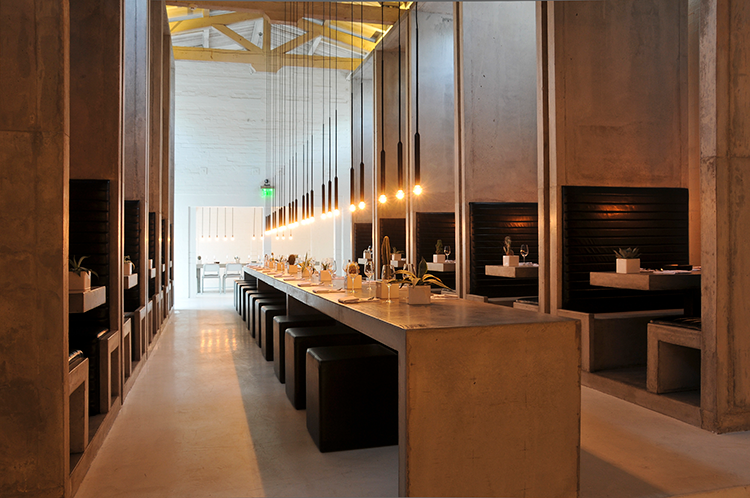
The Workshop Kitchen + Bar, designed by Soma architect collective in 2012, included work with the design company PSLab to create custom lighting fixtures to complement the concrete elements. Courtesy of Workshop Kitchen + Bar.
IF YOU ASK A LOCAL FOR A RESTAURANT recommendation, chances are you’ll be directed to Workshop Kitchen + Bar in the Uptown Design District. Located in a ninety-year-old retrofitted movie theater, the restaurant, which earned a James Beard Award for Best Restaurant Design, serves up farm-to-table fare, such as the house-cured gravlax tartine and the kabocha squash risotto, along with cocktails like the Palm Springer, a vodka concoction with pineapple juice and bitters. Architecture collective Soma conceived the minimalist interior outfitted with concrete booths and custom lighting.
Sandfish Sushi & Whiskey, also on North Palm Canyon Drive, is the brainchild of chef Engin Onural, who has whipped up a menu comprised of both traditional and experimental takes on Japanese dishes, like the spicy tuna tostada or the braised Spanish octopus with edamame hummus. Local architect Chris Pardo created a palette of concrete, wood, and fish tiles to achieve the interior’s Japanese-Scandinavian aesthetic.
Spencer’s is an enduring favorite among Palm Springers. Connected to the historic Palm Springs Tennis Club, where a number of celebrities hobnobbed, the eatery has a shaded outdoor patio that is perfect for a leisurely lunch. Order the generously portioned Baja shrimp salad and sip a Bee’s Knees while enjoying some good people-watching.
To indulge in a delectable cocktail, stop by Seymour’s, hidden behind a velvet curtain in the classic steak joint Mr. Lyons. The dimly lit lounge exudes that speakeasy feel with its wood-beam ceiling and salon-style arrangement of artworks featuring Victorian-era men in top hats and tailcoats. Try one of the many specialty cocktails like the Little Owl, with rye and walnut liqueur.
LODGING
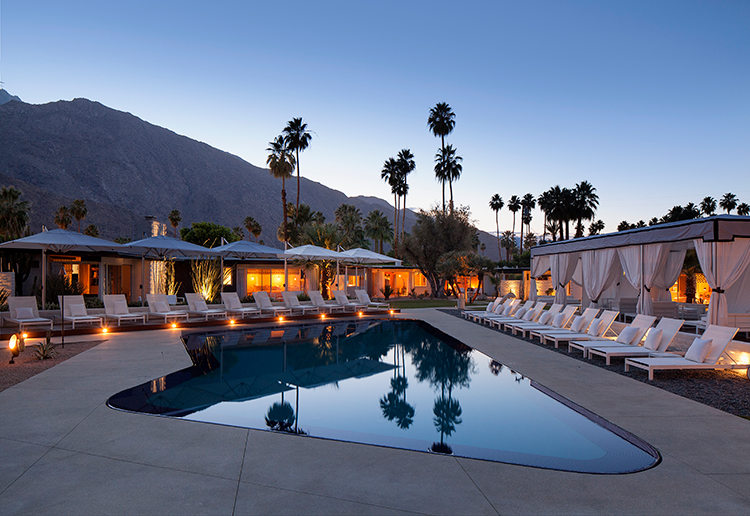
A view of the pool and lodgings at L’Horizon Resort and Spa. Courtesy L’Horizon Resort and Spa.
FOR THOSE HANKERING FOR A LITTLE LUXURY tinged with old-school glam, L’Horizon Resort and Spa is the place to stay. Originally built by William F. Cody in 1952 as a retreat for Hollywood producer Jack Wrather (of Lassie and The Lone Ranger), the complex consists of twenty-five low-slung bungalows built to host Wrather’s famous guests, such as Betty Grable and President Reagan. A few years ago interior designer Steve Hermann gave the property an extensive renovation, returning it to its former grandeur as a new boutique hotel. The infinity-edge pool and landscaped grounds are steps away from the private bungalows and provide mountain views. Rooms are furnished with mid-century chairs by the likes of Knoll and Katavolos and lighting by designers such as Brendan Ravenhill.
The Lautner Compound might be a dream-come-true for mid-century design wonks. Located in Desert Springs—a twenty-minute-drive northeast of Palm Springs—the compound offers lodging in four recently restored units originally designed by Lautner in 1947 as part of a never-realized master-planned community catered to Tinseltown. Refurbished by interior designer Tracy Beckmann and furniture designer Ryan Trowbridge, the flats provide today’s amenities set in a quintessential modernist landmark.
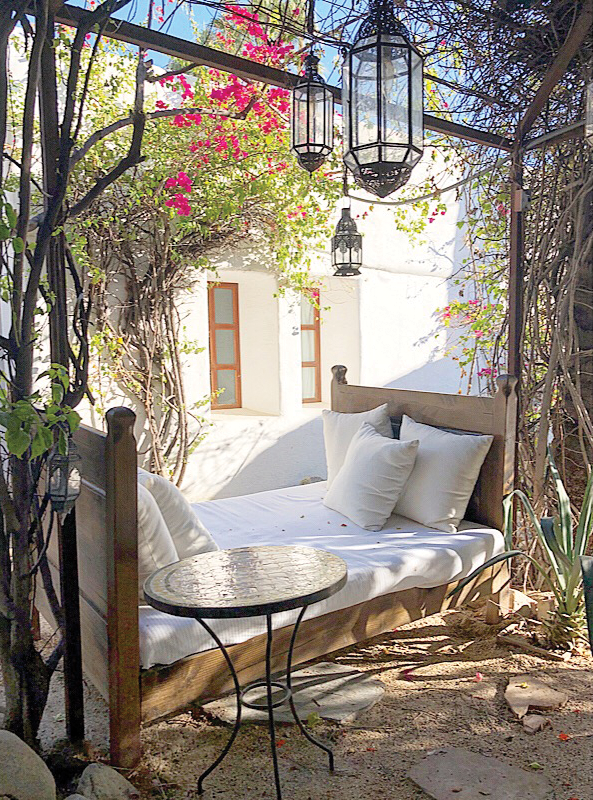
The Moroccan Villa at Korakia Pensione. Anderson photo.
Korakia Pensione is a refreshing departure from the ubiquitous mid-century-designed hotels dotting Palm Springs. With its lush courtyards of citrus blossoms and olive trees, it transports you to Morocco or Greece. One part of the hotel was built in 1924 as Dar Marroc, for Scottish painter Gordon Coutts, who sought to re-create his time in Tangiers, and hosted artist friends like Grant Wood. The hotel’s whitewashed villas are a blend of Mediterranean and Moorish influences, filled with antiques and furnishings from abroad.



